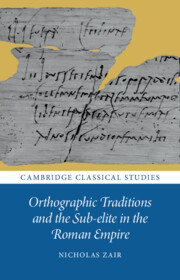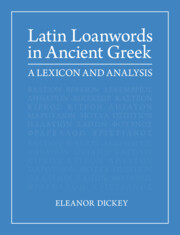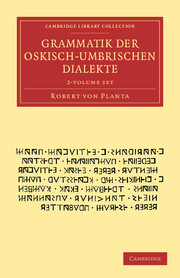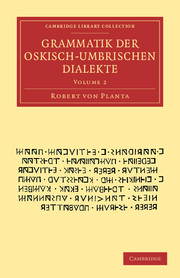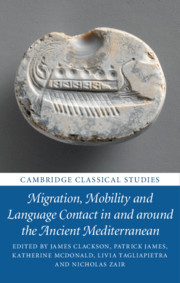Orthographic Traditions and the Sub-elite in the Roman Empire
This book makes use of digital corpora to give in-depth details of the history and development of the spelling of Latin. It focusses on sub-elite texts in the Roman empire, and reveals that sophisticated education in this area was not restricted to those at the top of society. Nicholas Zair studies the history of particular orthographic features and traces their usage in a range of texts which give insight into everyday writers of Latin: including scribes and soldiers at Vindolanda, slaves at Pompeii, members of the Praetorian Guard, and writers of curse tablets. In doing so, he problematises the use of 'old-fashioned' spelling in dating inscriptions, provides important new information on sound-change in Latin, and shows how much can be gained from a detailed sociolinguistic analysis of ancient texts.
- Demonstrates that spelling change in the Roman alphabet was a complex and unpredictable process
- Examines the use of optional spelling features in sub-elite texts to reveal that the sub-elite could have access to a relatively high level of education
- Makes use of digital corpora to give in-depth details of the history and development of relevant orthographic features and sound change across the history of Latin
Reviews & endorsements
‘… rewarding for epigraphists and linguists, and indeed for anyone interested in the development of Latin orthography and the Latin language, as well as those interested in sub-elite populations and their textual reflection in the Roman empire.’ Brent Vine, Mawr Classical Review
Product details
June 2023Hardback
9781009327664
314 pages
223 × 145 × 24 mm
0.52kg
Available
Table of Contents
- 1. Introduction
- Part I. Old-fashioned Spellings:
- 2.
for /aḙ/ - 3.
and for /i:/ - 4.
for /u/ - 5.
for /u:/ - 6. Alternation of and
- 7.
for /we/ before a coronal - 8.
and for /wu/ and /uu/, and and for /kwu/ - 9. Double letters to write long vowels
- 10.
for /g/ - 11.
for /jj/ - 12.
before /(a:)/ and before /u(:)/
- 13.
for /k/ before back vowels - 14.
for /ks/ - 15. Geminates and singletons
- 16. spepondi
- 17. popl- and pupl- for publ-
- Part II. Apices and i-longa:
- 18. Introduction
- 19. Apices and i-longa in the Isola Sacra inscriptions
- 20. Apices in the Vindolanda tablets
- 21. Apices in the tablets of the Sulpicii
- 22. Apex use in teh Vindolanda and TPSupl. tablets in comparison
- 23. Apices in the tablets from Herculaneium
- 24. I-longa in the tablets of the Sulpicii and the tablets from Herculaneum
- 25. Conclusions
- Appendix.

